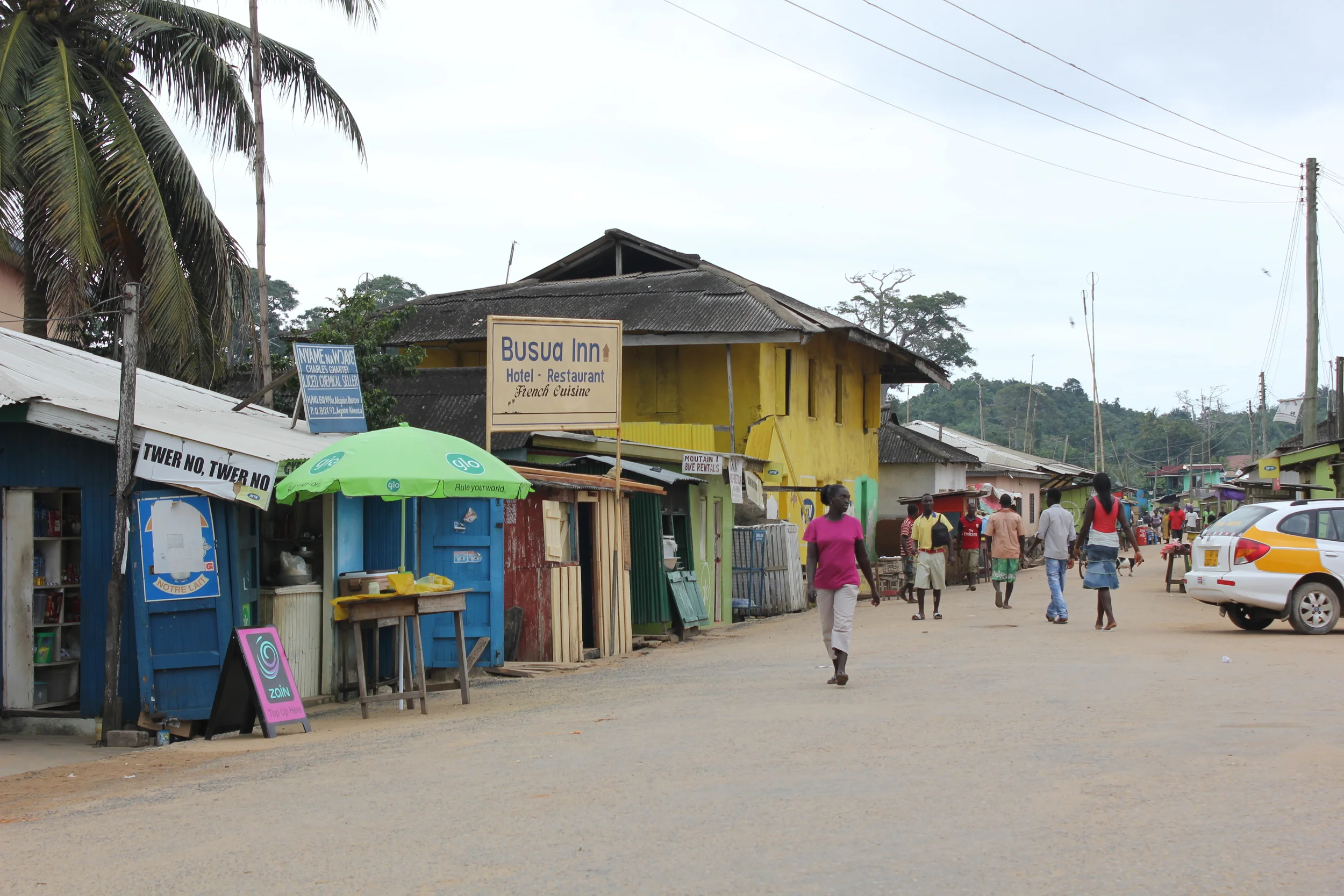
BUSUA
Busua is a small fishing village of 2000 inhabitants on the west coast of Ghana. During your stay you will experience the traditional way of life in a coastal Ghanaian settlement. Early in the morning, the fishing boats are pulled into the sea accompanied by rhythmic chants that have echoed over the beach for centuries. When the boats return from the sea, they bring in catches of tuna, swordfish, dorado and lobster. Women and children will gather around and bring their purchase home for dinner – elegantly balancing it in large trays on their head.
In the evenings you will experience the influence of the younger generation when colourful lights come on and afrobeats are coming through the speakers. One of the most common ways to spend the evenings is on the beach, in front of the bonfire where you can enjoy traditional drumming and reggae rhythms.
The locals are welcoming to new visitors, if you take your time to greet people you are sure to have a smile and a greeting back. If you stop for a chat, or memorise some phrases of the local language, you may even end up with new friends!
Busua has only one paved road, frequent power cuts and more goats than cars in the streets; truly an “off the beaten path” destination. Nevertheless, it makes for a relaxing holiday where you can disconnect and unwind.
At Busua Beach you will meet friendly local people as well as international visitors. We receive people from all over the world, but the beach is so big that it’s not difficult to find your own space for some quiet time.
“Loved Busua, such an amazing place. Great people and great surf! Peter and Kofi will teach you how to surf and even organize surf trips to other remote locations. The shop is well equipped and there are loads of nice places to stay in Busua. Be sure to spend more than just a couple of days there!!”
Busua is the capital of the Ahanta State. Historically, the Ahanta land was known as one of the richest areas on the coast of what is now Ghana. The country of Ahanta used to be a regional power with a confederacy of chiefdoms which came in early trading contact with the European nations settling on the Gold Coast.
The West Coast of Ghana has an old European fort in almost every bay, with some dating back to the 15th century. Several forts changed hands in bloody battles or by treaty, and all have fascinating history. Today, some have been restored and have a variety of uses, while some are ruins. Most are open to the public.
AKWIDAA – Fort Dorothea: Built by Branderburghers, 1685. In ruins today
ANKOBRA – Fort Eliza Cathargo: Built by the Dutch in 1702; only traces of ruins are now visible
AXIM – Fort St. Antonio: Portuguese trading post in 1502. Destroyed by the townspeople in 1514. Second Fort built by the Portuguese on present site in 1515
BEYIN – Fort Apollonian: Dutch Lodge C.1660. British Fort built between 1750 and 1770. Reconstructed between 1962 and 1968
BUTRE – Fort Batenstein: Swedish Post 1650-2. Dutch Fort built in 1656
DIXCOVE – Fort Metal Cross (Dick’s Cove). Work commenced in 1683. Restored 1954-66
PRINCESS' TOWN - Groot-Friederichsburg: Danish Lodge 1658. Fort built in 1683.
Busua is the capital of the Ahanta State. Historically, the Ahanta land was known as one of the richest areas on the coast of what is now Ghana. The country of Ahanta used to be a regional power with a confederacy of chiefdoms which came in early trading contact with the European nations settling on the Gold Coast.
The West Coast of Ghana has an old European fort in almost every bay, with some dating back to the 15th century. Several forts changed hands in bloody battles or by treaty, and all have fascinating history. Today, some have been restored and have a variety of uses, while some are ruins. Most are open to the public.
AKWIDAA – Fort Dorothea: Built by Branderburghers, 1685. In ruins today
ANKOBRA – Fort Eliza Cathargo: Built by the Dutch in 1702; only traces of ruins are now visible
AXIM – Fort St. Antonio: Portuguese trading post in 1502. Destroyed by the townspeople in 1514. Second Fort built by the Portuguese on present site in 1515
BEYIN – Fort Apollonian: Dutch Lodge C.1660. British Fort built between 1750 and 1770. Reconstructed between 1962 and 1968
BUTRE – Fort Batenstein: Swedish Post 1650-2. Dutch Fort built in 1656
DIXCOVE – Fort Metal Cross (Dick’s Cove). Work commenced in 1683. Restored 1954-66
PRINCESS' TOWN - Groot-Friederichsburg: Danish Lodge 1658. Fort built in 1683.
These forts sprang up since European traders had a demand for gold mined not far from the coast. By the end of the 19th century, Ahanta was one of a number of coastal states which included from the west: Axim, Ahanta, Jabu, Aguafo, Fete, Fante, Agona and Accra.
In August you can experience the the Ahanta people's celebration of the Kundum Festival
Kundum is a harvest festival with dancing, drumming, and feasting. It was in its original state a religious festival that was used to expel evil spirits from the town. Today, Kundum is celebrated as a way to preserve the culture of the Ahanta people and neighboring Nzema. The festival previously was one month long but, has recently been condensed to eight days.
(Source: National Commission on Culture)

